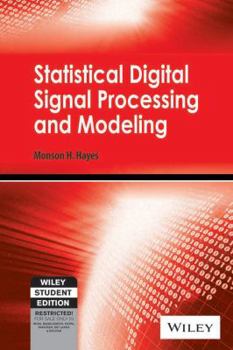Statistical Digital Signal Processing And Modeling
Select Format
Select Condition 
Book Overview
This new text responds to the dramatic growth in digital signal processing (DSP) over the past decade, and is the product of many years of teaching an advanced DSP course at Georgia Tech. While the... This description may be from another edition of this product.
Format:Paperback
Language:English
ISBN:8126516100
ISBN13:9788126516100
Release Date:January 2008
Publisher:Wiley
Length:624 Pages
Weight:1.54 lbs.
Customer Reviews
5 ratings
Excellent book
Published by Thriftbooks.com User , 16 years ago
I took adaptive signal processing at Georgia Tech with Dr. Hayers. This book was used as reference for the class. I really enjoyed reading it. It is concise, to the point, with lots of example and matlab source code which acctually worked. I had learned a lot. More importantly I was able to put into practise during my 9 years industry experience after graduation. Good reference book, I recommend to everyone who is serious about this topic.
Clear, concise, and clean
Published by Thriftbooks.com User , 19 years ago
This book very clearly explains advanced topics in DSP. The notation is consistent and very clean, as well as the book layout and the writing. The examples are useful and the review section is very helpful. This is how a technical book should be written.
awesome book
Published by Thriftbooks.com User , 21 years ago
Clear examples, clean derivations, and easy to understand style has Monson Hayes' his signature written all over it. I have his schaum's outline on DSP, and its just as good. I haven't finish perusing this book; i am currently on signal modeling (ch.3, i think) where pade, shank and other methods are derived, and i've already found plenty of application to work on. homework problems include both mathematical and computer (matlab) exercises that help cement understanding the material at the end of each chapter.applicable, yet theoretically appealing, this book is best for those who has had an introductory DSP course, although it is very much self-contained - the author starts with a comprehensive review of linear algebra and random processes - it will serve the serious student with an interest on statistical description of signals and system very well.
Examples ! Examples! Examples
Published by Thriftbooks.com User , 23 years ago
The book is beautiful, really neat. It contains all the essential topics that you will expect in a Spectral Analysis book. I stumbled across it in library and was impressed with the treatment that the author gave this subject. I now have a copy of my own. The topics range from basic to advanced including a few topics on adaptive filter theory.Each treatment is almost immediately followed by an example, simple but powerful way to introduce you to this topic. I found this one feauture made the topics covered really enjoyable. Linear algebra review captures the essence of the style of this book. It is a welcome addition to this area in DSP. The one by Stocia is too mathematical to be called an introductory book. This one is way much above Stocia's mathematical nightmare.
Jack of all trades, master of some
Published by Thriftbooks.com User , 24 years ago
I used this book to learn nearly all the topics covered in a hurry, in order to take the prelim exam at Berkeley. While it was a humbling experience, it made me truly learn to appreciate and love this book, and its great presentation and organization.It starts off with a very good introduction to linear algebra and probability theory for engineers, which should give you a taste of the effective way that this book is laid out. The format is excellent, and the important points clearly highlighted. This is a real joy to read!The magic doesn't wear off into the later chapters, which include topics in signal modeling, least-squares methods, MMSE estimation, Levinson algorithm, spectral estimation, and adaptive filters.I find this book to be a great source for both learning and reference, and as a bonus it includes Matlab codes for all the algorithms mentioned here.One complain is that there are certain topics that could be covered more effectively. For example, the relationship between the different signal models and filtering is not mentioned, and this could help understand the motivation of the different signal models in the first place.Anyway, once you get past Oppenheim/Schafer, Proakis/Manolakis and Lyons' material this can be a great way to start your journey into the more advanced topics in signal processing.





